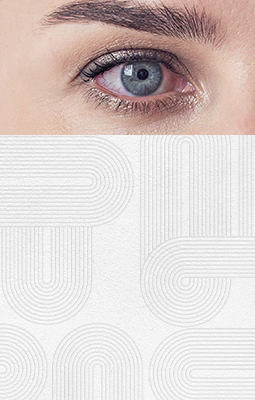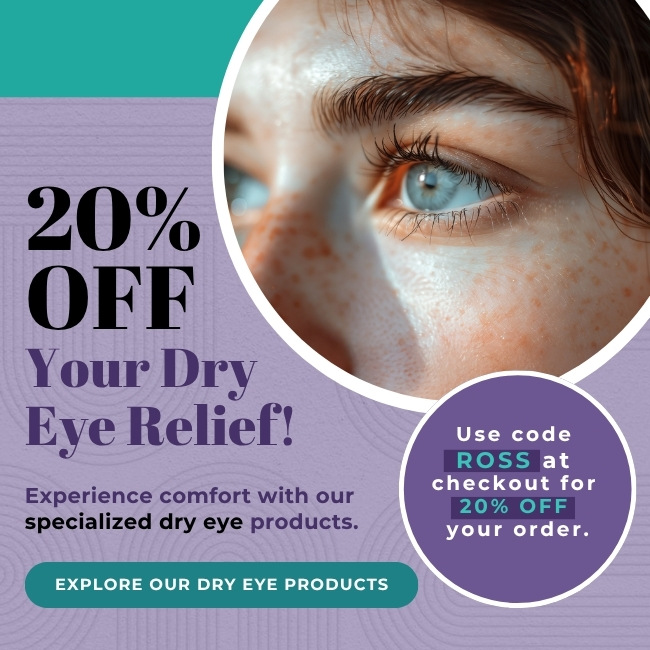What Causes Dry Eye?
Dry eye is caused by a disruption of the tear film which coats the cornea, the surface of the eye. Certain risk factors contribute to dry eyes including the environment, wearing contacts, being over 50 and female, certain medications and autoimmune conditions. There are 3 layers of the tear film: An oily layer, a watery layer and a mucin layer. Any disruption in one of these layers can cause dry eye.
Dry eye may result if tear production is low, the structure of your eyelids prevent proper spreading of the tear film or if your tear film evaporates too quickly. During your exam we will evalute how well your eyes make tears, how long it takes for your tears to evaporate and your eyelid structure.
Blepharitis
Blepharitis is a condition where the eyelids become red, itchy, swollen and crusty. This is due to an overpopulation of bacteria living on the eyelid. Blepharitis can lead to clogging of the oil glands and dry eye.
Meibomian Gland Dysfunction (MGD)
Meibomian Gland Dysfunction occurs when the meibomian glands, responsible for producing the oily layer of the tear film, get clogged or disrupted, and the oil is no longer sufficiently produced. This causes the moisture from the fluid layer to evaporate due to the lack of an oily layer, also known as evaporative dry eye.
Ocular Rosacea
Ocular Rosacea is a chronic inflammatory condition and presents similarly to a rosacea flare-up of the skin. Signs of Ocular Rosacea include small dilated blood vessels on the lid margins, blepharitis, thickened eyelid margins and dry eyes.
Sjogren’s Syndrome
Sjogrens Syndrome is an autoimmune condition often resulting in symptoms of dry eye and dry mouth. Often Sjogrens Syndrome coexists with other autoimmune conditions such as Lupus or Rheumatoid Arthritis.
Styes
A stye is a red inflamed bump on the eyelid often from bacteria in the oil gland. Untreated blepharitis may result in styes.
Lagophthalmos
Lagophthalmos is an incomplete closure of the eyelids causing dryness in the eyes. Some examples of conditions that cause lagophthalmos are eyelid surgery, Bell’s palsy and stroke.

Frequently Asked Questions About Dry Eye
How common is dry eye?
Dry eye is common, affecting approximately 16 million Americans. Fortunately, there are treatment options to help relieve the symptoms of dry eye and halt the progression of the disease.
Why doesn’t dry eye affect everyone?
Dry eye can affect anyone but certain risk factors make it more likely to occur. The most common risk factors are aging, hormonal changes, underlying health issues, environmental conditions, allergies and contact lens wearing. Taking early action can prevent mild symptoms from progressing into a more severe problem. A dry eye assessment helps identify if you need treatment.
If I don’t treat dry eye now, what will happen?
Leaving dry eye untreated may lead to eye infections, corneal abrasions, corneal ulcers and vision loss. This may ultimately affect your quality of life.
Can dry eye be cured?
Dry eye is a chronic, progressive condition and cannot be cured. There are in office treatments to halt the progression of the disease and make living with dry eye manageable.
Can digital eye strain cause dry eye?
Extended screen use can cause your eyes to feel dry and uncomfortable. When we are engaged in screen time, our blinking frequency decreases and eyelids don’t fully close. This results in the tear film failing to spread evenly across the eye causing dry spots.
What’s the difference between gels, ointments, and artificial tears?
The main difference between artificial tears, ointments, and gels is that artificial tears are thinner. A gel or ointment will be thicker and last longer in the eye providing extended moisture. These tend to work better for severe cases. Gels and ointments can also be medicated to combat bacterial growth and reduce inflammation.
How can I have dry eyes if my eyes water?
Reflex tears are made when your eyes get dry and your body sends a signal to your lacrimal gland to produce tears. Unfortunately these tears are not tears that help lubricate well. Lubricating tears are made of mucous, water, oil, protein and antibodies. Reflex tears are mostly water.
How can the 20-20-20 rule help digital eye strain?
The 20-20-20 rule is a handy guideline you can use to give your eyes a well-deserved break.
Here’s how it works: Every 20 minutes, look away from your screen and focus on something about 20 feet away for at least 20 seconds. This change in focus helps your eye muscles relax after you’ve been staring at close-up work for a long time.
Check out our blinking exercises sheet, too. It’s filled with more handy tips to keep your eyes happy and healthy.
Learn More By Contacting Us
Dr. Ross is dedicated to educating her patients about dry eye, risk factors and available treatment options. To learn more and get a dry eye evaluation contact our office.
Book AppointmentVisit Our Locations
Your eye health journey begins here, with two locations in the New York area to serve you. In the Bronx, you can find us in Dr. Terraciano’s Practice, and in Larchmont, we are located within Larchmont Eye Associates. We look forward to welcoming you to either of our convenient locations for your dry eye relief and eye care needs.
Bronx
- 2241 Esplanade
- Bronx, NY 10469
- Phone: 718-654-7122
- Fax: 718-547-5876
- Email: [email protected]
Hours of Operation
- Monday: 9:00 AM – 5:00 PM
- Tuesday: 9:00 AM – 5:00 PM
- Wednesday: 9:00 AM – 5:00 PM
- Thursday: Closed
- Friday: Closed
- Saturday: Closed
- Sunday: Closed
Larchmont
- 2365 Boston Post Rd #202
- Larchmont, NY 10538
- Phone: 914-834-2020
- Email: [email protected]
Hours of Operation
- Monday: 10:00 AM – 6:00 PM
- Tuesday: 9:00 AM – 5:00 PM
- Wednesday: Closed
- Thursday: 11:00 AM – 7:00 PM
- Friday: Closed
- Saturday: 9:00 AM – 1:30 PM
- Sunday: Closed






